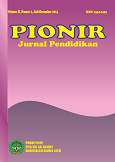APPLICATION OF THE TIME TOKEN ARENDS LEARNING MODEL IN SCIENCE LEARNING TO IMPROVE STUDENTS' LEARNING OUTCOMES IN ELEMENTARY SCHOOL/MI
DOI:
https://doi.org/10.22373/4cmy4c71Keywords:
time token arends, learning outcomes.Abstract
of teachers in implementing learning, in accordance with the field of study that is their responsibility. Teacher readiness is shown pedagogically, namely in choosing and determining the right learning model, in accordance with the subject matter and characteristics of students. Initial data on science learning in class V MIN 26 Aceh Besar, showed that most of the students' learning outcomes had not been able to achieve the KKM (Minimum Completion Criteria), which was 70. The purpose of this study is to analyze teacher and student activities, as well as student learning outcomes using the Arends time token learning model in IPAS learning in elementary schools. The research method used was classroom action research. Data collection was carried out in accordance with the stages of classroom action research, namely planning, implementation, observation, and reflection of learning, as well as assessment of student learning outcomes. The results of the study found that teacher activity in cycle I was categorized as good (79.00%), while in cycle II teacher activity increased very well (91.40%). Student activity in cycle I was categorized as good (78.10%), while in cycle II student activity experienced a very good increase (92.40%). Student learning outcomes in cycle I were completed (53.33%). In cycle II student learning outcomes increased by achieving a complete score (86.70%). The results of the cycle I and cycle II tests showed that the application of the Time Token Arends learning model could improve student learning outcomes at MIN 26 Aceh Besar. Analysis of the results of this study showed that active participation in student learning through the application of the time token Arends learning model correlated with the improvement and strengthening of student understanding of the material taught by the teacher, which was indicated by an increase in student learning outcomes.
Keywords: Time token arends, learning outcomes
References
Ambarwati, Arie. (2018). Prilaku dan Teori Organisas. Malang: Media Nusa Creative.
Amyani, Era Siska. (2018). Penerapan Model Discovery Learning Untuk Meningkatkan Aktivitas dan Hasil Belajar Siswa. Jurnal Pendidikan dan Pembelajaran Biologi, Vol. 2, No. 1.
Andriani, Rike. (2019). Motivasi Belajar Sebagai Determinan Hasil Belajar Siswa. Jurnal Pendidikan Manajemen Perkantoran. Vol. 4, No. 1.
Besare, Stefen Deni. (2020). Hubungan Minat dengan Aktivitas Belajar Siswa. Jurnal Inovasi Teknologi Pembelajaran. Vol. 7, No. 1.
Dewi, Syofi Syofiyah, dkk. (2020) Pengaruh Model Pembelajaran Kooperatif Tipe Time Token Arends Terhadap Keterampilan Sosial Peserta Didik di Kelas. Jurnal Penelitian Pendidikan, Vol. 7, No. 1.
Hopkins, David A. (2010). Teacher’s Guide to Classroom Research. Philadhelpia: Open University Press.
Maisarah, dkk. “Peningkatan Hasil Belajar Peserta Didik Melalui Media Pop-Up Book pada Pembelajaran Tematik Kelas V MIN 04 Aceh Besar”. Jurnal Pendidikan, Vol. 10, No. 2 (2021) h. 151.
Malabar, Sayama. (2021). Buku Ajar Pembelajaran Terpadu. Gorontalo: Ideas Publishing.
Nurrita, Teni. (2018). Pengembangan Media Pembelajaran untuk Meningkatkan Hasil Belajar Siswa. Jurnal Ilmu-Ilmu Al-quran, Hadist, Syariah dan Tarbiyah, Vol. 3, No. 1.
Pristiwanti, Desi, dkk. “Pengertian Pendidikan”. Jurnal Pendidikan dan Konseling, Vol. 4, No. 6 (2022) h. 7912.
Putri, Nurul Madaniya. (2018). Penerapan Model Pembelajaran Time Token Arends untuk Meningkatkan Hasil Belajar IPS Siswa Kelas 4 Tema Indahnya Keberagaman di Negeriku SDN 2 Slempit Kedamean Gresik. JPGSD, Vol. 06, No. 11.
Rahayu, Astrini. (2019). Penerapan Model Pembelajaran SAVI Untuk Meningkatkan Aktivitas Belajar Siswa. Jurnal Pendidikan Guru Sekolah Dasar, Vol. 4, No. 2.
Rismayani. (2020). Penanaman Sikap Sosial Melalui Pembelajaran IPS”. Jurnal Pendidikan IPS Indonesia, Vol. 4, No. 1.
Rusman. (2017). Belajar dan Pembelajaran Berorientasi Standar Proses Pendidikan. Jakarta: Kencana.
Sanjaya, Wina. (2008). Strategi Pembelajaran Berorientasi Standar Proses Pendidikan. Jakarta: Kencana Prenada Media Grouf.
Setiawan, Raden Heri. (2020). Upaya Meningkatkan Prestasi Belajar Matematika Siswa Melalui Penerapan Model Time Token Arends. Jurnal Akademik Pendidikan Matematika, Vol. 6, No. 2.
Sholikha, Khabibatus. (2017). Penerapan Model Pembelajaran Time Token untuk Meningkatkan Hasil Belajar Siswa pada Pembelajaran IPS Kelas V MI Bahrul Ulum Surabaya”. Jurnal PGSD, Vol. 5, No. 3.
Utami, Sri. (2022). Metode Pembelajaran Time Token Arends. Cirebon: Wiyatama Bestari Samasta.
Downloads
Published
Issue
Section
License
Copyright (c) 2025 Mawardi Mawardi

This work is licensed under a Creative Commons Attribution-ShareAlike 4.0 International License.
- Authors retain copyright and grant the journal right of first publication with the work simultaneously licensed under a Creative Commons Attribution License that allows others to share the work with an acknowledgment of the work's authorship and initial publication in this journal.
- Authors are able to enter into separate, additional contractual arrangements for the non-exclusive distribution of the journal's published version of the work (e.g., post it to an institutional repository or publish it in a book), with an acknowledgment of its initial publication in this journal.
- Authors are permitted and encouraged to post their work online (e.g., in institutional repositories or on their website) prior to and during the submission process, as it can lead to productive exchanges, as well as earlier and greater citation of published work (See The Effect of Open Access).

